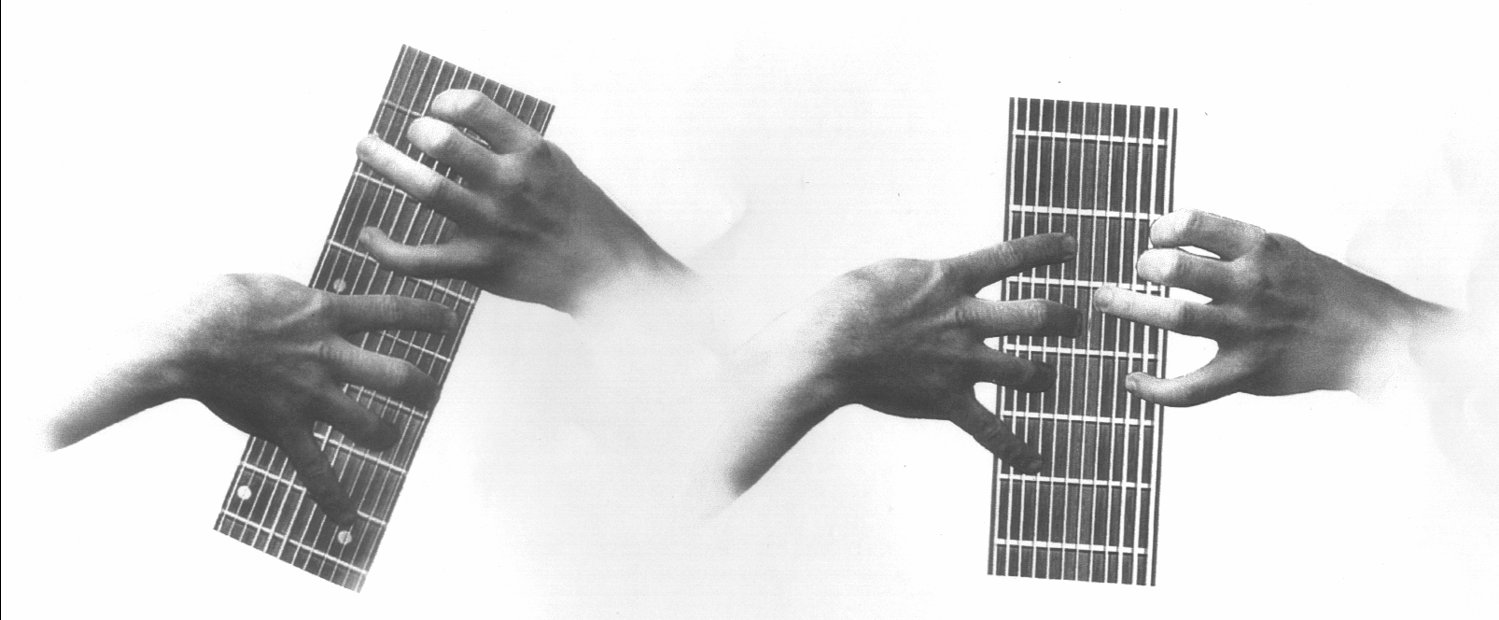(From Daniel Schell’s book : “MySpace”)
The number of different tunings in usage today has increased and offers to the player many solutions adapted to his style. In order to describe fully a tuning you have to consider the following elements :
1. The tuning is said to be uniform in fourths (or fifths) if the interval between the strings is only fourths (or fifths). Sometimes the tuning is not uniform, like on the Spanish or the Crafty guitar.
2. The tiptar has one or two playing regions. The guitar has only one region.
3. If it has two regions : Tuning of the melody side or of the bass side.
4. ” : The hands are crossed or uncrossed on the board.
5. ” : The hands play parallel or mirrored.
1.1.1 The « tuning word »
In order to describe a tuning we shall use a « word » : the tuning word. The first example we shall give is « 1<5_mel_4ths_RH // 5_bass_5ths_LH > 10 » seen from the player.
To read this « tuning word », you have first to think that you see your tap-guitar from behind, that is as you actually play it. This is the reason why I write « seen from the player ». In full words this would mean : 5 melody strings, tuned in 4ths ascending towards the left situated string#1, played with the Right Hand/ AND / 5 bass strings ascending in fifths towards the right situated string #10, played with the Left Hand.
The first figure you see is a 1. This is the number of the string #1, exactly as on the classical guitar.
After that you see 5_Mel_4ths_RH, which means 5 melody strings in fourths played by the Right Hand. The sign 1< , means that that the 5 melody strings in fourths ascend towards the left in direction of string # 1.
The other side reads as 5 bass strings tuned in fifths, played by the Left Hand, and the sign >10 means ascending towards the right situated string #10.
1.1.2 Families of tuning intervals
1.1.2.1 ONE-REGION BOARDS
– This type of board has only one playing region, like on the classical guitar.
– Strings ascend usually to the left of the player.
– Both hands play on the same region.
1.1.2.2 TWO-REGIONS BOARDS
– The board is divided into two regions. (or the tiptar has two necks).
– Each region is either in fourths or in fifths.
– One hand plays one region, but that is not a rule.
Table 1-1 The four arrangements of a two regions board
| bass | melody |
| fourths | fourths |
| fourths | fifths |
| fifths | fourths |
| fifths | fifths |
If we account for separate bass and melody tuning, we find four possible tuning super-families (see). One can see that the two families fifths-fifths and fourths-fourths are reflective, in other words, both sides require identical hand motions. On the other hand, the fifths-fourths and fourths-fifths tunings are not reflective: both sides require different hand motion.
1.1.3 Crossed hands – uncrossed hands tunings
Suppose you see your board from behind, as seen from the player. If you play with your right hand on the left side of the board, and your left hand on the right side, then you play « crossed hands ». You are in the family « 1_RH // LH_10 ». On the contrary, if you play with each hand on their respective sides then you play « uncrossed hands » and belong to the family « 1_LH // RH_10 ».

Figure 1-1 On the left, the playing with crossed hands. On the right, playing with uncrossed hands. Advantage of this last position : The hands do not interfere with each other in their vertical movements. (Drawing by Paul Catteau)
1.1.4 Mirrored hands, parallel hands
Our hands show symmetry, they are ‘mirrored’ . Suppose you wish to play a given pattern with both hands, say C-F-G-c from FIGURE 1-2. What is the natural way to play it? The ‘mirrored’ option, says that the patterns should be mirrored like the hands. In other words, the tuning should be mirrored. The author of the present book believes in this option. This is the ‘accordion’ effect: When you play an identical pattern on both sides, your hands go both in mirrored directions.
If you come from the guitar world, and wish to play two times guitar. Then you believe in the ‘parallel’ playing. The ‘parallel’ option says that the patterns should be parallel unlike the hands. This is the ‘piano’ effect: When you play an identical pattern on both sides, your hands go both in parallel directions.
1.1.5 A Quick guide: Which tuning should I play?
You want one region playing.
You wish to tap on an ordinary guitar ?1.2.1
You wish to extend the possibilities of the guitar to 8-str-? 1.2.2.1
You are a Crafty fan, and you do not wish to play the classical lines-? 1.2.2.2
You want two-regions playing.
You wish to read music with both hands and be able to play bass lines:
you don’t know which bass to choose?
You play mostly chords, you like the sound of open fifths in your accompaniment
Fifths-fourths, crossed hands?1.3.2.2
Fifths-fourths, uncrossed hands?1.3.3
Choose a tuning with the bass in fourths?
You are attached to your old guitar habits and want a melody upon it:
You like the idea of parallel uncrossed hands?1.3.1.5.1
You like the idea of parallel crossed hands?1.3.1.5.2
You like the idea of mirrored uncrossed hands?(bass in middle)1.3.1.3
You have no special guitar habits (Hell with these old habits!):
You like the idea of mirrored uncrossed hands (bass on sides)?1.3.1.2
You are an ex-Chapman tuning player AND:
You wish to go for uncrossed fourths-fourths: ?1.3.1.2
Not much time, a quick try to crossed fourths-fourths: ?1.3.1.4
You wish to play two-regions ‘crafty’ like:
Pure crafty? 1.5.1.1
‘Best of both worlds’ ?1.5.2